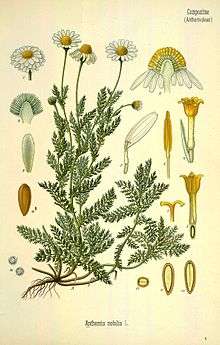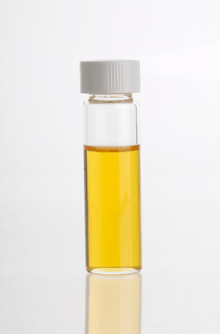Chamaemelum nobile
| Chamomile | |
|---|---|
 | |
| Chamaemelum nobile[1] | |
| Scientific classification | |
| Kingdom: | Plantae |
| Clade: | Angiosperms |
| Clade: | Eudicots |
| Clade: | Asterids |
| Order: | Asterales |
| Family: | Asteraceae |
| Genus: | Chamaemelum |
| Species: | C. nobile |
| Binomial name | |
| Chamaemelum nobile | |
| Synonyms | |
|
Anthemis nobilis L. | |
Chamaemelum nobile commonly known as chamomile (also spelled camomile), Roman chamomile,[2] English chamomile,[2] garden chamomile, ground apple, low chamomile, mother's daisy or whig plant,[3] is a low perennial plant found in dry fields and around gardens and cultivated grounds in Europe, North America, and in Argentina. C. nobile is, along with Matricaria chamomilla, an important source of the herbal product known as chamomile.[2]
Description
Chamaemelum nobile has daisy-like white flowers and procumbent stems; the leaves are alternate, bipinnate, finely dissected, and downy to glabrous. The solitary, terminal flowerheads, rising 20–30 cm (8–12 in) above the ground, consist of prominent yellow disk flowers and silver-white ray flowers. The flowering time in the Northern Hemisphere is June and July, and its fragrance is sweet, crisp, fruity and herbaceous.[4]
Etymology
The word chamomile, and the genus name Chamaemelum come from the Greek χαμαίμηλον (chamaimēlon), "earth-apple",[5] from χαμαί (chamai), "on the ground" + μήλον (mēlon), "apple", so-called because of the apple-like scent of the plant. (Note: The "ch-" spelling is used especially in science and pharmacology.)
Non-medicinal use

The plant is used to flavor foods, in herbal teas, perfumes, and cosmetics.[4] It is used to make a rinse for blonde hair, and is popular in aromatherapy; its practitioners believe it to be a calming agent to reduce stress and aid in sleep.
It can also be used to create a fragrant camomile lawn. A chamomile lawn needs light soil, adequate moisture, and sun in order to thrive. Each square meter contains 83-100 plants. The lawn is only suitable to light foot traffic or in places where mower access is difficult.[6]
Medicinal use
It can be applied directly to the skin for pain and swelling, but there is no good evidence it has any beneficial effect.[7]
The appropriate dose of Roman chamomile depends on several factors such as the user’s age, health, and several other conditions. At this time there is not enough information to determine an appropriate range of doses for Roman chamomile. It is not recommended to take orally during pregnancy as it can cause uterine contractions and miscarriage.[8] It is not known if Roman chamomile interacts with any medications. There are no known interactions with other herbs and supplements. There are no known interactions with foods.[7]
Other names
Anthémis, Anthémis Odorante, Anthemis nobilis, Babuna Ke Phool, Camomille d’Anjou, Camomille Noble, Camomille Romaine, Chamaemelum nobile, Chamomilla, Chamomile, Chamomillae Ramane Flos, English Chamomile, Fleur de Camomille Romaine, Flores Anthemidis, Garden Chamomile, Grosse Kamille, Ground Apple, Huile Essentielle de Camomille Romaine, Low Chamomile, Manzanilla, Manzanilla Romana, Ormenis nobilis, Roman Chamomile Essential Oil, Romische Kamille, Sweet Chamomile, Whig Plant.[7]
References
- ↑ 1897 illustration from Franz Eugen Köhler, Köhler's Medizinal-Pflanzen
- 1 2 3 "German Chamomile". University of Maryland Medical Center. 2011. Retrieved 14 December 2012.
- ↑ T. K. Lim Edible Medicinal And Non-Medicinal Plants: Volume 7, Flowers at Google Books
- 1 2 Gualtiero Simonetti (1990). Stanley Schuler, ed. Simon & Schuster's Guide to Herbs and Spices. Simon & Schuster, Inc. ISBN 0-671-73489-X.
- ↑ Chamaimelon, Henry George Liddell, Robert Scott, A Greek-English Lexicon, at Perseus
- ↑ "Camomile lawn". rhs.org. Retrieved 21 July 2015.
- 1 2 3 "Roman chamomile: MedlinePlus Supplements". medlineplus.gov. US National Institutes of Health. Retrieved 3 August 2017.

- ↑ "Roman chamomile". Medline Plus Supplements. National Institutes of Health. 2012. Retrieved 14 December 2012.

![]()
External links
- English chamomile entry in the public domain NCI Dictionary of Cancer Terms
- Chamomile Plantlife website - species listing
| Wikimedia Commons has media related to Chamaemelum nobile. |
| Wikispecies has information related to Chamaemelum nobile |